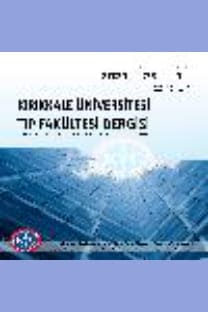İDİYOPATİK PARKİNSON HASTALARINDA OLFAKTÖR BULBUS VOLÜM VE OLFAKTÖR SULKUS DERİNLİĞİNİN MANYETİK REZONANS GÖRÜNTÜLEME İLE DEĞERLENDİRİLMESİ
Parkinson hastalığı, olfaktör bulbus, manyetik rezonans görüntüleme, olfaktör sulkus, olfaktör sulkus
Evaluation of Olfactor Bulbus Volume and Olfactor Sulcus Depth MRG in Idiopathic Parkinson Disease
___
- 1. Lees AJ, Hardy J, Revesz T. Parkinson's disease. Lancet, 2009;373(9680):2055-66.
- 2. Mueller A, Mungersdorf M, Reichmann H, Strehle G, Hummel T. Olfactory function in Parkinsonian syndromes. J Clin Neurosci. 2002;9(5):521-4.
- 3. Barz S, Hummel T, Pauli E, Majer M, Lang CJ, Kobal G. Chemosensory event-related potentials in response to trigeminal and olfactory stimulation in idiopathic Parkinson’s disease. Neurology. 1997;49(5):1424-31.
- 4. Hawkes CH, Shephard BC. Olfactory evoked responses and identification tests in neurological disease. Ann NY Acad Sci.1998;855:608-15.
- 5. Martines-Marcos A. On the organization of olfactory and vomero nasal cortices. Prog Neurobiol. 2009;87(1):21-30.
- 6. Buschhüter D, Smitka M, Puschmann S, Gerber JC, Witt M, Abolmaali ND et al. Correlation between olfactory bulb volume and olfactory function. NeuroImage. 2008;42(2):498-502.
- 7. Huart C, Meusel T, Gerber J, Duprez T, Rombaux P, Hummel T. The depth of the olfactory sulcus is an indicator of congential anosmia. Am J Neuroradiol. 2011;32(10):1911-4.
- 8. Duprez TP, Rombaux P. Imaging the olfactory tract. Eur J Radiol. 2010;74(2):288-98.
- 9. Mueller A, Abolmaali ND, Hakimi AR, GloecklerT, Herting B, Reichmann H et al. Olfactory bulb volumes in patients with idiopathic Parkinson’s disease-a pilot study. J Neural Transm. 2005;112(10):1363-70.
- 10. Hawkes CH, Shephard BC, Daniel SE. Olfactory dysfunction in Parkinson’s disease. J Neurol Neurosurg Psychiatry. 1997;62(5):436-46.
- 11. Wang J, You h, Liu JF, Ni DF, Zhang ZX, Guan J. Association of olfactory bulb volume and olfactory sulcus depth with olfactory function in patients with Parkinson disease. Am J Neuroradiol. 2011;32(4):677-81.
- 12. Altmann J. Autoradiographic and histological studies of postnatal neurogenesis. IV. cell proliferation and migration in the anterior forebrain, with special reference to persisting neurogenesis in the olfactory bulb. J Comp Neurol. 1969;137(4):433-57.
- 13. Graziadei PPC, Graziadei GM. Neurogenesis and neuronregeneration in the olfactory system of mammals. III. Deafferentation and reinnervation of the olfactory bulb following section of the fila olfactoria in rat. J Neurocytol. 1980;9(2):145-62.
- 14. Rui K, Zhang Z, Tian J, Lin X, Wang X, Ma J et al. Olfactory ecto-mesenchymal stemcells possess immunoregulatory function and suppress autoimmune arthritis. Cell Mol Immunol. 2016;13(3):401-8.
- 15. Altinayar S, Oner S, Can S, Kizilay A, Kamisli S, Sarac K. Olfactory disfunction and its relation olfactor bulbus volume in Parkinson's disease. Eur Rev Med Pharmacol Sci. 2014;18(23):3659-64.
- 16. Tanik N, Serin HI, Celikbilek A, Inan LE, Gundogdu, F. Associations of olfactory bulb and depth of olfactory sulcus with basal ganglia and hippocampus in patients with Parkinson’s disease. Neuroscience letters. 2016;620:111-4.
- 17. Tandberg E, Larsen JP, Aarsland D, Laake K, Cummings JL. Risk factors for depression in Parkinson disease. Arch Neurol. 1997;54(5):625-30.
- 18. Negoias S, Hummel T, Symmank A, Schellong J, Joraschky P, Croy I. Olfactory bulb volume predicts therapeutic outcome in major depression disorder. Brain Imaging Behav. 2016;10(2):367-72.
- 19. Huisman E, Uylings H, Hoogland PV. A 100% increase of dopaminergic cells in the olfactory bulb may explain hyposmia in Parkinson's disease. Mov Disord. 2004;19(6):687-92.
- ISSN: 2148-9645
- Yayın Aralığı: Yılda 3 Sayı
- Başlangıç: 1999
- Yayıncı: KIRIKKALE ÜNİVERSİTESİ KÜTÜPHANE VE DOKÜMANTASYON BAŞKANLIĞI
İskemik Kolon Anastomoz İyileşmesinde Timokinon, Zeolit ve Plateletten Zengin Plazmanın Etkinliği
Faruk PEHLİVANLI, Gökhan KARACA, OKTAY AYDIN, Canan ALTUNKAYA, İbrahim Tayfun ŞAHİNER, Hüseyin ÖZDEN, Hafize UZUN, Mevlüt Recep PEKCİCİ
TEKRARLAYAN GEBELİK KAYBINDA HEMATOLOJİK PARAMETRELERİN ÖNEMİ
Mahmut İlkin YERAL, Buğra ÇOŞKUN, Bora ÇOŞKUN, Mehmet KARSLI, Coskun SİMSİR
Eylem KARATAY, Kebire KARAKUŞ, Deniz ÖĞÜTMEN KOÇ, Rahime ÖZGÜR
SERVİKAL LAMİNEKTOMİ SONRASI EPİDURAL HEMATOM VE LHERMİTTE BULGUSU: OLGU SUNUMU
Mustafa ÖĞDEN, Süleyman AKKAYA, Alemiddin ÖZDEMİR, Mehmet Faik ÖZVEREN
Epiploik Apendiks Enflamasyonu: Primer Epiploik Apandajit
OKTAY AYDIN, Faruk PEHLİVANLI, Gökhan KARACA, Çağatay DAPHAN, KUZEY AYDINURAZ, akan BOYUNAĞA, Salim NESELİOGLU, Özcan EREL
HİPOFİZ SAPI KESİLME SENDROMU MR GÖRÜNTÜLEME BULGULARI: ÜÇ OLGU SUNUMU
